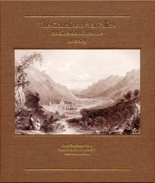"Emigration became the only viable option, since there appeared to be no hope of improving the situation back home."

 |
The Courdins of Val Pellice:
A Waldensian Chronicle by Jim Staley Good Buy Sweet Prints
book review by John E. Roper
The study of history focuses on a variety of topics such as world wars, key inventions, and significant events that have formed the foundation of our present age. Yet at the center of every movement, revolution, or great breakthrough have been ordinary people whose lives were the building blocks of societal change. The vast majority of these individuals never find their way into the textbooks, since most histories only concentrate on a handful of the more famous movers and shakers of a specific culture. Yet the stories of those who are not as well-known are still of importance in the overall chronology of the past, and most especially to their descendants. With this in mind author Jim Staley has written a comprehensive overview of one specific family, the Courdins, spanning four generations that is rich in anecdotes, photographs, and lore.
Staley's history begins in a small region on the eastern slopes of the Cottian Alps in Italy, sometimes referred to as the Waldensian Valleys due to the high percentage of people from that particular religious group who settled there. One of the valleys, Val Pellice, is named for the stream which winds through it on its way to the Po River, as is a tiny hamlet on its banks, Villar Pellice. The latter is also the ancestral home of the Courdins, a Waldensian family who can date their presence in the village from at least 1586. The Waldenses in the area had been free of severe religious persecution for almost 200 years, but by the middle of the 19th century, economic conditions in their valleys threatened to destroy them. In desperation the governing body of the Waldensian church began investigating locations for its members to emigrate to, and in 1856 community meetings were being held with up to 600 villagers in attendance to discuss the issue. By years end, the first wave of a growing exodus of Waldensian families from their European enclave would burst upon the shores of South America. In less than two decades, many of these families would move again, but this time to the United States.
Although the author spends much of the early part of the book giving his readers an excellent overview of events leading up to the exodus, the move itself, and the nineteen years of struggle in Uruguay, the bulk of his history focuses on the individual Courdin families descended from those early emigrants. In addition, he includes some of the history of extended lines such as the Long family who hail from the neighboring Val Chisone in Italy. Most chapters concentrate on a single branch of the family tree and include brief stories, birth and death information, and an abundant assortment of photographs of the individuals mentioned. However, general researchers on the family might find the final two sections of particular interest as they focus on specific places of importance to family history and include detailed information such as a handy table listing descendants and spouses, source material, etc.
Staley's book is strengthened by the depth of his research, the care he takes to give each family line equal representation, and the wealth of supporting photographs and illustrations he uses to make his subjects real to the reader and not just a collection of names in a dusty genealogy. While it will mainly appeal to the descendants of the various Courdin lines, Staley's attractive and well-designed book should also be of value to anyone who enjoys exploring family lore.